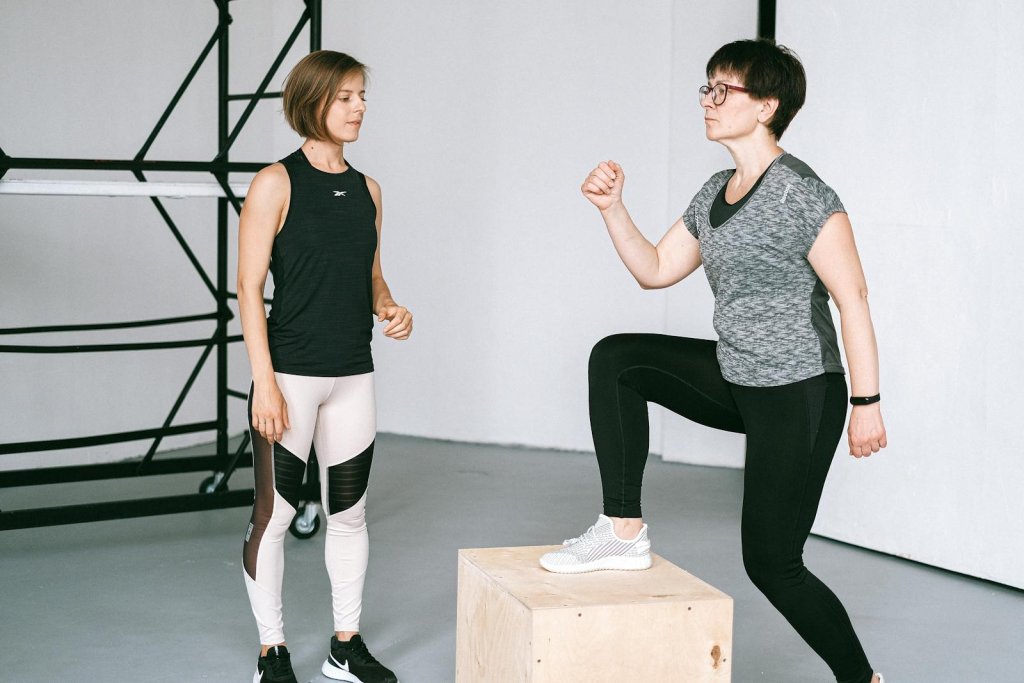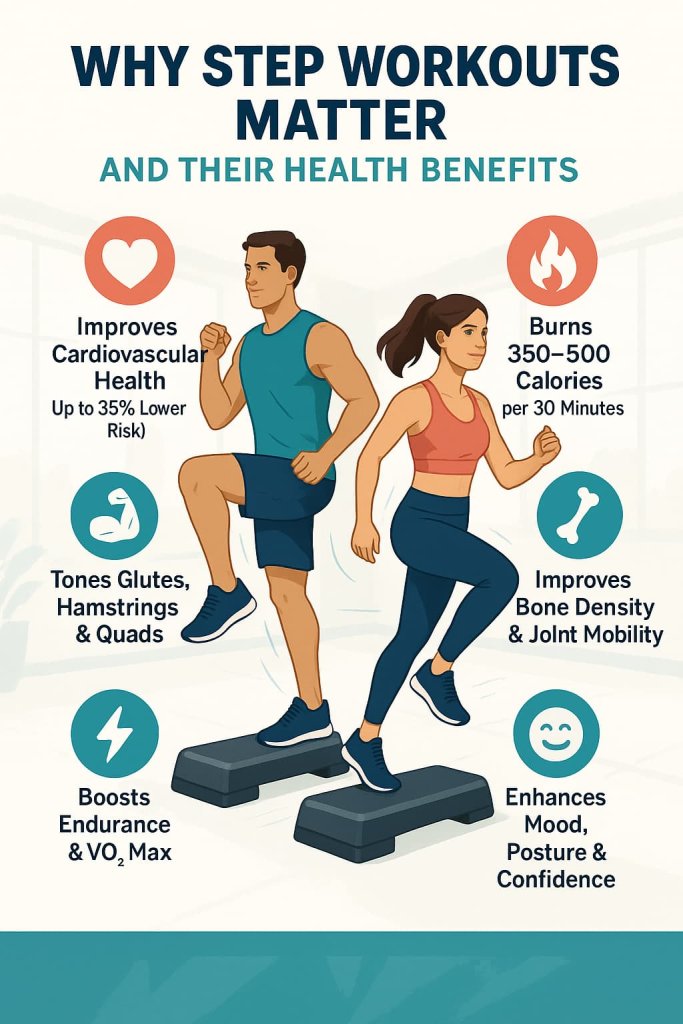Step exercises are one of the most effective full-body workouts to burn fat, tone your muscles, and improve endurance — all with minimal equipment.
By simply using a step platform or sturdy surface, you can build strength in your legs, glutes, and core while boosting cardiovascular fitness and coordination.

Why it matters: Step training blends cardio and strength — making it ideal for weight loss, muscle definition, and overall fitness. Whether at home or in the gym, these low-impact moves torch calories while protecting your joints.
According to the Journal of Sports Medicine (2025), step training performed 3 times a week for 30–40 minutes can improve VO₂ max (aerobic endurance) by 17–22% and lower body fat by 8–10%.
Let’s explore 15 of the best step exercises backed by science and proven to deliver results.
Why Step Workouts Matter and Their Health Benefits
Step workouts offer a simple yet powerful way to burn fat, tone muscles, and improve heart health — no fancy equipment required.
They combine strength and cardio training, making them ideal for anyone seeking total-body fitness with low joint impact.

According to the American Heart Association (2024), consistent step training can reduce cardiovascular disease risk by up to 35% while improving endurance and leg power.
A 30-minute session can burn 350–500 calories, and research in the Journal of Sports Medicine (2025) confirms step workouts boost VO₂ max, balance, and coordination.
Regular step training also:
- Strengthens glutes, hamstrings, quads, and calves
- Improves bone density and joint mobility
- Enhances energy, posture, and overall mood
In short, step exercises are efficient, joint-friendly, and backed by science — a smart way to stay strong, lean, and heart-healthy at any age.
15 Best Step Exercises
These 15 step exercises target every major muscle group while improving balance, coordination, and cardiovascular endurance.
Incorporate them into your weekly routine to burn fat, build lean strength, and stay fit with minimal equipment.
1. Basic Step-Up
Why it works:
The foundational move for all step workouts — it improves leg strength, balance, and coordination while activating stabilizer muscles. It also enhances functional strength for daily tasks like climbing stairs.
Muscles worked:
Quadriceps, glutes, hamstrings, calves.
How to do it:
- Stand tall facing the step.
- Step onto the platform with your right foot.
- Push through your heel to lift your body up, bringing the left foot to meet it.
- Step down one foot at a time.
- Alternate legs for each rep.
Trainer Tip:
Start with a 6–8 inch step height and keep your knee aligned with your ankle — not past your toes.
2. Step-Up with Knee Raise
Why it works:
Combines lower-body power with core engagement to improve balance, coordination, and calorie burn.
Muscles worked:
Glutes, hamstrings, hip flexors, abs.
How to do it:
- Step up with your right foot.
- Lift your left knee up toward your chest at the top.
- Lower slowly back to start and switch sides.
Trainer Tip:
Avoid leaning forward — maintain a tall spine to activate your core and glutes efficiently.
3. Lateral Step-Up
Why it works:
Targets hip abductors and outer thighs, improving lateral movement strength for sports and daily stability.
Muscles worked:
Gluteus medius, quads, hamstrings, adductors.
How to do it:
- Stand beside the step.
- Step laterally with your right foot, then bring your left foot up.
- Step down the same way and switch sides.
Trainer Tip:
Use a mirror to ensure even hip alignment and proper posture throughout.
4. Step Jump (Plyometric)
Why it works:
Builds explosive power, coordination, and cardiovascular endurance — excellent for fat burning and athletic performance.
Muscles worked:
Quads, glutes, calves, core.
How to do it:
- Stand behind the step.
- Jump up with both feet onto the platform.
- Land softly with knees slightly bent, then step back down.
Trainer Tip:
Engage your core and land quietly — this ensures control and reduces joint strain.
5. Step Lunges
Why it works:
Enhances leg strength, balance, and flexibility while targeting large muscle groups for toning and fat loss.
Muscles worked:
Glutes, hamstrings, quads, calves.
How to do it:
- Place your right foot on the step.
- Lower into a lunge until your back knee hovers above the floor.
- Push through your front heel to return to standing.
Trainer Tip:
Keep your front knee directly above your ankle to avoid joint stress.
6. Step Burpees
Why it works:
A total-body calorie-burner combining cardio, core, and strength training in one powerful movement.
Muscles worked:
Chest, shoulders, triceps, quads, glutes, core.
How to do it:
- Stand facing the step.
- Place your hands on it and jump your feet back into a plank.
- Jump feet forward, then step or jump onto the platform.
- Repeat continuously.
Trainer Tip:
Control your plank form — don’t drop your hips, and exhale as you jump up.
7. Step Push-Ups
Why it works:
Tones your upper body with a gentler incline push-up that still engages the core for stability.
Muscles worked:
Chest, shoulders, triceps, core.
How to do it:
- Place hands shoulder-width apart on the step.
- Extend legs behind into a straight plank.
- Lower your chest to the step, then press back up.
Trainer Tip:
To increase intensity, reverse the position — place your feet on the step and hands on the floor.
8. Step Mountain Climbers
Why it works:
Drives your heart rate up while strengthening your abs, shoulders, and hip flexors — a perfect cardio-core combo.
Muscles worked:
Core, shoulders, triceps, hip flexors, quads.
How to do it:
- Start in plank with hands on the step.
- Alternate driving your knees toward your chest at a controlled pace.
Trainer Tip:
Avoid bouncing your hips — keep your body in a straight line to engage your core.
9. Crossover Step-Ups
Why it works:
Engages inner thighs, obliques, and stabilizers through rotational movement, improving coordination and symmetry.
Muscles worked:
Adductors, glutes, quads, obliques.
How to do it:
- Stand beside the step.
- Cross your right foot over and place it on the step.
- Step up, bringing the left foot across, then step down the same way.
Trainer Tip:
Slow and controlled movement maximizes muscle engagement and safety.
10. Reverse Step-Ups
Why it works:
Emphasizes glutes and hamstrings more than standard step-ups, building hip extension power and lower-body strength.
Muscles worked:
Glutes, hamstrings, calves.
How to do it:
- Face away from the step.
- Step backward with one foot, pressing through your heel to rise.
- Lower under control and alternate sides.
Trainer Tip:
Avoid pushing off your toes — keep the focus on your glutes and heels.
11. Step Side Kicks
Why it works:
Combines balance, coordination, and lateral strength for improved functional stability and core control.
Muscles worked:
Glutes, obliques, hip abductors, quads.
How to do it:
- Step onto the platform with your right foot.
- Lift your left knee, then extend the leg out to the side in a kick.
- Return slowly and switch sides.
Trainer Tip:
Engage your abs and avoid swinging your leg — control every motion.
12. Step Taps (Cardio Drill)
Why it works:
A high-energy move that boosts agility and burns calories while improving coordination and foot speed.
Muscles worked:
Calves, quads, hamstrings, core.
How to do it:
- Stand facing the step.
- Tap the top with alternating feet as quickly as possible.
- Maintain light, rhythmic movements.
Trainer Tip:
Follow an upbeat song (120–140 BPM) to sustain rhythm and intensity.
13. Step Plank Shoulder Taps
Why it works:
Enhances shoulder stability and core strength while training balance and anti-rotation control.
Muscles worked:
Shoulders, triceps, core, lower back.
How to do it:
- Place hands on the step in a plank position.
- Tap your left shoulder with your right hand, then switch.
- Keep hips level throughout.
Trainer Tip:
Engage your glutes and abs to prevent twisting.
14. Weighted Step-Ups
Why it works:
Adds resistance to build muscle size and strength while improving functional movement patterns.
Muscles worked:
Glutes, hamstrings, quads, calves.
How to do it:
- Hold dumbbells at your sides.
- Step up onto the platform, pushing through your lead leg.
- Step down slowly and repeat on both sides.
Trainer Tip:
Use light weights first; focus on smooth, controlled steps rather than speed.
15. Step Jump Squats
Why it works:
A powerful finishing move that builds explosive strength and rapidly elevates heart rate for fat loss.
Muscles worked:
Glutes, quads, hamstrings, calves, core.
How to do it:
- Stand on the step with feet shoulder-width apart.
- Perform a half squat, then jump down softly and return up.
- Repeat rhythmically.
Trainer Tip:
Land softly and engage your core — this reduces joint stress and enhances power output.
How to Structure a Step Workout Routine
A good step workout blends cardio, strength, and recovery for full-body results.
According to the American College of Sports Medicine (2024), 2–4 sessions per week lasting 20–40 minutes is ideal.
Basic structure:
- Warm-Up (5–10 min): Light marches and dynamic stretches.
- Workout (20–25 min): Alternate cardio drills (step taps, jump squats) with strength moves (lunges, step-ups).
- Cool Down (5 min): Gentle stepping and lower-body stretches.
Trainer Tip:
Use a 6–12 inch step and adjust speed (120–140 BPM) to match your fitness level. Focus on control, not speed.
Benefits of Step Exercises
Research from American Heart Association (2024) confirms that consistent step workouts:
- Burn 350–500 calories per 30 minutes, depending on intensity and body weight.
- Increase cardiovascular endurance and VO₂ max.
- Improve leg and glute tone while supporting bone health.
- Boost coordination, balance, and core engagement.
They’re beginner-friendly, joint-safe, and can be performed almost anywhere.
How Often Should You Do Step Exercises?
For best results:
- Beginners: 2–3 sessions per week, 20–30 minutes each.
- Intermediate/Advanced: 4–5 sessions per week, 30–45 minutes.
Combine step workouts with resistance training and stretching for balanced results.
Allow at least one rest day between high-intensity sessions.
Safety Tips Before You Start
- Choose a stable, non-slip platform (6–10 inches).
- Warm up 5–10 minutes with light cardio and mobility drills.
- Keep your knees aligned with toes.
- Land softly — avoid stomping.
- Maintain a neutral spine.
- Increase height or weight gradually.
FAQs
1. Are step exercises good for weight loss?
Yes. They elevate your heart rate and burn calories efficiently — up to 10 cal/minute at higher intensities.
2. Can beginners do step workouts?
Absolutely. Start with a low platform and slower tempo, then progress.
3. How high should my step be?
6–8 inches for beginners, 10–12 inches for advanced users.
4. What equipment do I need?
A sturdy aerobic step or even stairs work fine. Dumbbells optional.
5. Can step exercises replace cardio workouts?
Yes. They combine cardio and strength — ideal for fat burn and endurance.
6. Are they safe for knees?
When performed with control and proper alignment, they are low-impact and joint-friendly.
7. How long until I see results?
Visible improvements in endurance and muscle tone typically appear within 4–6 weeks of consistent training.
Conclusion
Step exercises are an efficient, versatile, and joint-safe way to burn fat, tone muscles, and boost stamina — no fancy gym required.
Start small, stay consistent, and progressively challenge yourself with new moves or added weights.
Take the first step today — literally — toward a stronger, leaner, and more energetic you.
References
- Step Aerobic Training Trial (2022, PMC) — 6–8″ step at ~130–140 BPM improved lower-body power/agility (great for practical specs)
https://pmc.ncbi.nlm.nih.gov/articles/PMC9762244/ - Bench Stepping Intensity vs. Step Height & Cadence (2016, PMC) — quantifies workload (≈+0.6 METs per +10 BPM; ≈+1 MET per +6 cm)
https://pmc.ncbi.nlm.nih.gov/articles/PMC4744003/ - Stair-Climbing Interventions & Cardiometabolic Outcomes (2023, Systematic Review, PMC) — evidence that “step” modalities improve VO₂max and risk markers
https://pmc.ncbi.nlm.nih.gov/articles/PMC10656261/
